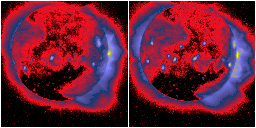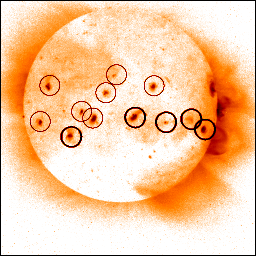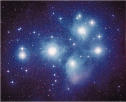
Introduction
This nugget notes another remarkable example of unexpected simultaneity in the appearance of coronal features. A previous nugget called attention to a remarkable triple jet, as yet unexplained if not an astonishing coincidence. In this nugget we go back to 1994, prior to the invention of science nuggets and therefore a great place to find new things, to show a puzzling coincidence in the formation of a swarm of tiny active regions. Here's the basic observation:

A close inspection (click to see better) shows that a small swarm (seven, in fact) of new active regions has appeared more or less overnight (these two images are 30 hours apart, which is more or less the expected time scale for the appearance of a new region).
The map below shows which are new (thin circles) and which old (thick circles):

So why shouldn't active regions appear
simultaneously?
Well, they always could if they wanted to - the so-called "Christmas tree efffect" that might explain extragalactic faster-than-lightspeed apparent motions. The analogy is the apparently coherent pattern of lights sometimes (seemingly often) seen in an array of randomly-flashing Christmas tree lights.
On the other hand, suppose we had to find a physical mechanism to explain the simultaneity? We believe that solar active regions result from the emergence of magnetic fields from below the photosphere. This happens only "slowly", at a few kilometers per second! Observed horizontal flows in the photosphere, due to convective motions in the interior, are even "slower". This kind of process can only be studied well by numerical simulations of the physics, as for example that reported here. Here fast and slow need to be interpreted in terms of the solar size scale. A horizontal flow of 1 km/s would cover only about 0.1 solar radii per day. That is why the appearance of a constellation of active regions, spread out over such a distance, seems striking. Thus, Hypothesis: there is no known physical mechanism, so this may well be one of those unique inexplicable things that simply does not have to be explained. But, if one could find a second case, one would be tempted to seek some bizarre explanation invoking new physics.
The Pleiades
Of course this nugget has nothing to do with the real Pleiades. Normally stars occur in clusters, rather than the other way around. But here is a pretty picture anyway:

Click for a larger version. Note that there traditionally are seven Pleiades, and by coincidence our simultaneous active regions were seven in number. But this of course is a bit arbitrary.
Note added in proof: For those not aware of this, "Pleiades" in the Japanese language is "Subaru", not only a car but also a telescope.
February 22, 2002
H. Hudson (hhudson@ssl.berkeley.edu), with thanks to D. Alexander and G. Slater